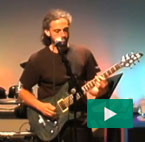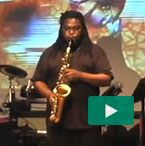In Sync With UAB’s Computer Music Ensemble
By Blake Tommey
Two words sum up the UAB Computer Music Ensemble (CME): far out. The 12-member group in the Department of Music mixes synthesizers with software—including Apple Logic, Reason, and ProTools—to create often-unconventional compositions.
Senior Andrew Hyde came to UAB to study music. What type of music, exactly, was still up in the air: he had no prepared instrument and wasn’t very keen on vocal performance, either. Then he discovered the CME.
“Singing in choir isn’t really my thing,” says the music technology major. “I’m here to write good music on computers and learn those techniques and styles. That’s my niche.” Hyde’s brand of music features everything from singing robots and electronic drum circles to Wii remotes that trigger modulated synthesizer notes.
(Story continues below slideshow)
Digital Collaboration
CME director and music technology professor Scott Phillips, Ph.D., can geek out with the best of them, but he admits his most important job is bringing down the hammer. “Most of the students who come to us are very creative and resourceful,” Phillips explains, “but if I didn’t focus that creativity with an idea or theme to build their music around each semester, we would never put on a show.”
|
Chips Off the Old Block UAB's Computer Music Ensemble has found a particularly appreciative fan base at Lost Mountain Middle School in Cobb County, Georgia, which has its own computer music club. Lost Mountain’s director, Jay Champion, met UAB's Scott Phillips at a conference last year, and the two decided to collaborate. This spring, the middle school students took a field trip to UAB to spend the day with their collegiate colleagues; this fall, they will return for the CME’s November 12 concert, where they will debut joint compositions. Later in November, the UAB CME will travel to Cobb County for a second concert. And in 2011, Champion and Phillips will share their experiences at music-teacher conferences in Ohio, Georgia, and Alabama. |
Theme selection means collaboration, says Phillips. For their spring 2010 concert, CME members settled on “Humanity,” a topic designed to counter the argument that computers remove the human element from music. For Phillips, the theme reflects a larger goal of the CME.
“We have a responsibility,” Phillips says. “Most people find electronic music very inaccessible; there’s only a very small community of people who really dig it. We try to make it accessible.”
Phillips encourages students to make music that is as creative and quirky as possible—and to provide visuals for the audience. At the “Humanity” concert in April, Justin Wallace created a robot to perform his Blade Runner-inspired composition, “Do Androids Dream the Impossible Dream?”
In the performance, the android, controlled from inside a refrigerator box by Wallace himself, believes it is human and begins singing “The Impossible Dream” from the musical Man of La Mancha, provided by a vocal recording. The robot’s harsh, metallic voice begins to overcome its singing, however, and eventually degenerates into a muddled mess of mechanical noise. In a climax of despair and malfunction, the android realizes it is not human and that its life is meaningless. But the mechanical man decides to make the best of the life it has and begins to make music again.
“I even used a quote from the book on which Blade Runner is based,” Wallace explains: “‘The electric things have their life too. Paltry as those lives are.’”
One of Wallace’s earlier works, “Dogs Exist on a Different Time Plane,” earned him an invitation to the National Conference of the Association for Technology in Music Instruction this September in Minneapolis, where he will present a session on the composition of the piece.
|
Click below to hear a clip from Andrew Hyde's piece "The Power of Two." |
The Sound of Success
CME students don’t just score music; they also score paying gigs. Wallace, who currently designs sound for multiple Birmingham theater companies, has dreamed of working in the field “ever since I first saw Star Wars as a kid and heard a lightsaber,” he says. “With a music technology degree, I can teach lessons, perform professionally, do sound design, compose music, or do studio recording and even live sound.”
Hyde, who identifies himself as “a recovering World of Warcraft fanatic,” admits his dream job would be designing sound for video games—which requires both musical and technical creativity. “Say you’re playing a game that takes place in the future and requires futuristic sounds,” Hyde says. “As a sound designer, you have to either take existing sounds and modify them, or create brand-new sounds with synthesizers.”
Rows of intrigued students and faculty now fill the seats where small numbers of parents and CME alumni used to sit during performances. Audiences are definitely treated to a unique musical experience, Hyde says. “A lot of people show up and don’t know what they’re getting into.”
More Information
Get tips and tricks from computer music experts in a video tutorial series at the UAB Computer Music Ensemble blog.

